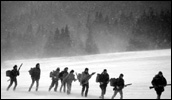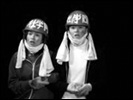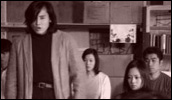United Red Army
- Year
- 2008
- Original title
- Jitsuroku Rengo Sekigun Asama-sanso e no Michi
- Japanese title
- 実録・連合赤軍 あさま山荘への道程
- Director
- Cast
- Running time
- 190 minutes
- Published
- 22 September 2008



by Rea Amit
In 1691 Japan's greatest poet Matsuo Basho had returned from a long journey, one that gave birth to his most important work, Oku no Hosomichi - which might be translated as "the narrow road to the inner(land)". It is a very private report which Basho gave on the land and to people whom he came across on his journey and is written in his unique poetic style, alongside many haiku poems and aesthetical threads. Koji Wakamatsu is not someone likely to appear in the same context with Basho, given the still vigorously upheld division between "high" and "low" art. Nevertheless, Wakamatsu's United Red Army is above all a work for which he, like Basho, covered extended distances, both mental and physical; from a creative point of view, the journey may even have taken a lifetime. The film's full title in Japanese is "The true story of the United Red Army: the road to the Asama mountain retreat", which shares a certain resemblance with that of Basho's most famous complete work, and which might symbolically suggest Wakamatsu's embracement by a mainstream audience and a more honorable entry into the pantheon of the Japanese cinema.
It would be quite easy to go so far as to conclude that even though Wakamatsu's filmography now includes several dozen accomplished works, United Red Army is without doubt his most complete, ambitious, and overwhelming work to date. It was achieved only after a few years of flooding Tokyo with pamphlets requesting pledges of substantial sums of money to finance the project (signatories of these pamphlets included musician Jim O'Rourke, who composed the film's musical score, and film critic Inuhiko Yomota). In other words, we could say that the movie is a zenith in Wakamatsu's oeuvre, towards which he had been heading for a long time, far earlier even than the actual production process.
One piece of evidence for this is to be found in many similarities that the movie shares with Wakamatsu's earlier work; right from the opening it is striking to see footage of the vibrant student demonstrations of the sixties, similar to those we saw opening some of his other pictures like: Running in Madness, Dying in Love (Kyoso Joshi-ko, 1969), Season of Terror (Teroru no Kisetsu, 1969) and Sex Jack (Seizoku, 1970). And of course the film's main theme, the revolutionary movements of the late sixties and early seventies, is not new to the director, who dealt with it already in his Ecstacy of the Angels (Tenshi no Kokotsu, 1972) and in particular in his documentary The Red Army/PFLP: Declaration of World War (Sekigun-PFLP: Sekai Senso Sengen, 1971). Moreover, the film itself does not introduce to Japanese cinemagoers a brand new narrative, as it actually follows quite a various range of published fictional and non-fictional literature, at least one dramatic play, and not less than three other cinematic features, all dealing pretty much with the same phenomena. One of them is the 2007 Masao Adachi film inspired by Red Army member Kozo Okamoto, who took part in an attack on Israel's international airport in 1972, Prisoner/Terrorist (Yuheisha - Terorisuto). Before we can go on to the other two films which deal specifically with the core of the United Red Army story - the Asama-sanso incident -, a historical introduction is required.
While student movements in Japan were active already since the establishment of the Taisho democracy, it was only after World War II that most of the groups were united under one name: zengakuren ("the united student movement"). Post-war students activists questioned the nature of the relationship between the capitalistic (and partial occupier) U.S.A. and the new pacifistic Japanese society. Their biggest activity was the planning and successful conducting of numerous mass demonstrations that were held near the American embassy, where crowds roared "Yankee go home!". In the early sixties and until the seventies the demonstrations grew dramatically wilder and much more energetic, as vividly expressed by their new moniker: zenkyoto ("the united fighting commune"). The result of this shift brought about for the fist time both radical and sometimes even deadly reactions from the authorities (notably the death of Tokyo University student Michiko Kanba during a demonstration). Surprisingly, the general public reaction towards the students also changed. If during the fifties a broad tolerance and even sympathy were the mainstream overview, the radical developments met with little or no sympathy at all. The students were starting to call for a revolution and they had new vocabulary articulating it, most importantly two blanket terms. Firstly, uchi-geba (geba comes from the German Gewalt, violence, uchi means inside) referred to action against other students whose revolutionary consciousness is questionable. Wakamatsu himself referred to (or rather exploited) the term in the title Violent Virgin (Shojo Geba-geba, 1969). The other term is somewhat similar but is much more important for the United Red Army framework: sokatsu. It is hard to translate, since its normal meaning is basically "summary". However in those days, to the students belonging to the movement it referred to one's own verification of his or her own activities or thoughts in accordance with the revolutionary idea. Unfortunately, the outcomes of the usage of this term were not private or psychological, between each man and his conscience, but rather they brought in some cases fatal criticism or alienation, and in the worst cases went so far as to bring actual physical punishments. This new terminology was then followed by a general escalation in violent actions towards the establishment by several radical groups, different branches of the Red Army, which culminated in two events that would take place a few weeks from each other in 1972: the Lod Airport shootings and the Asama-sanso incident that forms the finale to Wakamatsu's United Red Army.
The depiction of revolutionary groups in films reached a certain peak during the sixties, as the American involvement in Vietnam turned grim and as a reaction to the French student riots. Oshima was one of the earliest in this category with his 1960 film Night and Fog in Japan (Nihon no Yoru to Kiri), then came Gillo Pontecorvo's remarkable The Battle of Algiers (La Battaglia di Algeri) and of course the work of Jean-Luc Godard, in particular his La Chinoise and Le Gai Savoir. Wakamatsu was without any doubt either influenced directly by these films or at least by the general atmosphere that led to their creation. On the other hand, while these films were produced in a rather enthusiastic ambiance, almost even intoxicated with the entire revolutionary "high-feeling" - its very high ideals, the utopian and romantic notion of changing the world - it seems as if Wakamatsu wanted to come to terms with the same subject, only with a noticeably more sober approach, in United Red Army.
While the above-mentioned films from the 1960s were fictional and dealt with almost theoretical revolutionary ideas, Wakamatsu declares in his film's title that it is a jitsuroku, a true record, an honest depiction of what really happened. This notion of jitsuroku is commonly linked to the filming style typical of Kinji Fukasaku, (presumably influenced by the Italian Neo-Realism of the forties and fifties) as most profoundly seen in his Battles Without Honor and Humanity saga (Jingi naki Tatakai, 1973-75). Its most obviously recognizable characteristics could be summed up as following: shooting in real outdoor locations and not in a studio, avoiding using tripods of any kind and instead relying on excessive use of a hand-held camera, the sometimes frantic or trembling shooting style and, in contrast, also using freeze frames and adding titles stating characters' identities, facts, and dates. All these do indeed come into play in United Red Army in a very intense fashion. Similar practices were also adopted partially in Banmei Takahashi's Rain of Light (Hikari no Ame, 2001), which also attempts to tell the story of what happened at Asama-sanso, except by using fictional characters in a reflective drama which tells the story of a bunch of people trying to shoot a film about the Asama-sanso event and the short period prior to it. Another slight diversion from the event is seen in Masato Harada's The Choice of Hercules (Totsunyu Seyo! Asama-sanso Jiken, 2002), which is based on a book written by Atsuyuki Sasa, who was the head of the police PR office and the director of the siege at Asama-sanso (and who later became the head of the Cabinet's Security Affairs Office). In contrast to these two cinematic depictions, Wakamatsu asks for an unbiased presentation and a faithfulness to the facts, in both their historical and human aspects. He was even quoted as saying that his film is 90% real, and that only the rest may be considered fictional.
After an opening hour introducing the Japanese student movements and the establishment of the Red Army, with a detailed underlining of the chief figures who took part in it, Wakamatsu goes on to depict in more dramatic style the foundation of the group's sub-branch called Rengo Sekigun (The United Red Army), in the mountain area of Gunma and Nagano prefectures. There the leader Tsuneo Mori (played by Go Jibiki), who finds himself in this position after the previous leader has been arrested, together with his female partner, Hiroko Nagata (played by Akie Namiki), starts to perform the revolutionary activity of sokatsu - eliminating by torture members of the group they find suspicious for any reason. It is a very harsh presentation to witness and it again reminds us abruptly of the violent exploitation cinema of Wakamatsu's early career. However, here the depiction of violence is much more mature, very realistic in the dramatic acting, and its effect is astonishing. It manages to peel away, layer after layer, the almost mystical, nostalgic, Che Guevara-like charm from revolutionary action, reducing it to a mere power-crazed, fear-based minor establishment, where law and order are maintained by leaders who behave erratically and chaotically.
In the final hour, after completely sobering out from the revolutionary euphoria, which is then turned into compassion and fear for the rest of the surviving members, the group splits for the last time. We follow one part of the group that walks up the mountains of Nagano prefecture toward their hideout. They continue their trek even after hearing on the radio that most of the rest of the members of the group, including the two leaders, have been caught by the police, but when the police spot and start to hunt them as well, they find themselves fleeing to the ski resort area Karuizawa. They hole themselves up inside a mountain lodge, taking its sole inhabitant hostage. The police soon surround the house but the members stand their ground for ten days, until the police finally break in, releasing the hostage and capturing the Red Army members alive.
The event shaped the young Eastern democracy, which from that point onwards became more capitalistic and gradually less socialist. It was probably one of the most viewed episodes in Japanese television history with an average of 50% and a peak of almost 90% reported rating. The leftist students might have wanted other images to be burnt onto the vast audience's minds, but what is still remembered until this day is actually the picture of "cup ramen", those instant noodles which are still very popular today, but which were seen then on screen for the very first time, used by the hundreds of policemen who were on duty for long hours around the clock in the freezing mountain temperatures of February.
Wakamatsu would like us to rethink this image and to inspire modern audiences, not, like the sixties revolutionary films, to glorified but empty political extravaganza, but rather to a sober deepening of our concern for our own society and to constantly think of ways to make it better. The students of the sixties and seventies were highly aware of their surroundings and took an active role in trying to shape it, while nowadays problems like global warming, the coming oil crisis, hunger in Africa, human rights around the world, and the new fear of another cold war seem to be left almost unconcerned. In July of 2008 the G8 meeting was held in Japan and went as smoothly and quietly as it ever has before, something that could serve to underline how Wakamatsu's cinematic achievement is relevant to an indifferent Japanese society. The director sacrificed his own mountain villa for the film, which stands in for the students' final hideout and was pretty much razed to the ground for the shoot. Wakamatsu is said to have sent his own daughter to be educated in Lebanon at a certain time in her life, which is a clear indication of what kind of a rigid radical he himself was at one point. However, while times may have changed for radicalism in the so-called developed world, The United Red Army expresses vividly both the need and the danger, the attraction and the revulsion of a revolution - which shouldn't be thought of exclusively as something of the past.